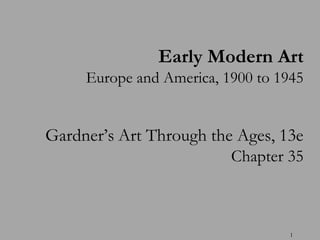The document provides an overview of early modern art in Europe and America between 1900 and 1945. It discusses the emergence of modernist movements like Fauvism, Cubism, Expressionism, Dada, and Futurism in Europe in response to World War I and social changes. It also examines the gradual development of modernist art in America, including the influential 1913 Armory Show that introduced avant-garde European art to the United States. Major artists of the period from both sides of the Atlantic like Matisse, Picasso, Duchamp, and Stieglitz are also highlighted.

























































































































